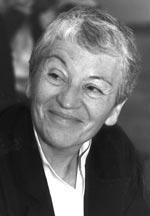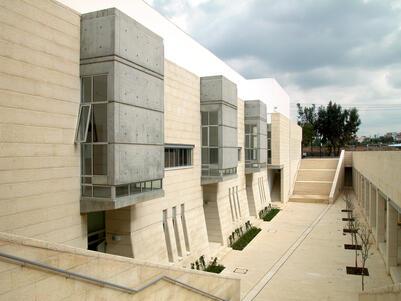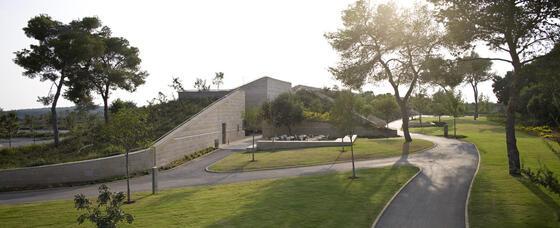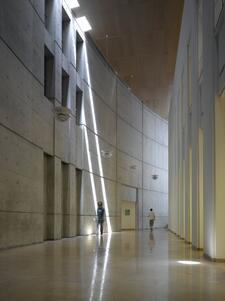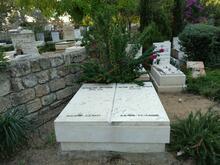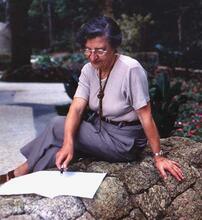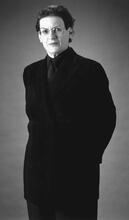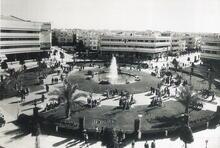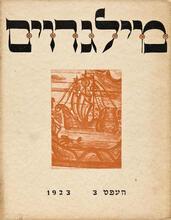Ada Karmi-Melamede
Ada Karmi-Melamede (b. 1936) is a prominent Israeli architect. She graduated from the Technion, Israel Institute of Technology in Haifa in 1963. Karmi-Melamede's work includes a variety of public and private projects, among them the Supreme Court Building in Jerusalem and The Open University campus in Ra’anana. Her architectural work combines universal modern architectural principles with local and historical ones. In 2007, she received the Israel Prize in architecture, the second woman to have ever received this prize. She belongs to a family of renowned architects: her father Dov Karmi was the first architect to receive the Israel Prize in architecture in 1957, and her brother Ram Karmi received the prize in 2002.
Family & Education
Ada Karmi-Melamede is a prominent Israeli architect who received the Israel Prize in architecture in 2007, the second woman to have ever received this prize. Karmi-Melamede was born December 24, 1936, in Tel Aviv, where she also grew up. Her father Dov (b. Odessa, 1905–1962), immigrated to Palestine with his parents in 1921. In 1930, he graduated from the School of Architecture and Engineering in Ghent, Belgium. Her mother, Haia (née Maklev, born in Petah Tikvah, 1909), was a dedicated homemaker who studied at the School of Social Studies in Montpelier, France.
After graduating from high school, Ada joined a Nahal paramilitary unit at a A voluntary collective community, mainly agricultural, in which there is no private wealth and which is responsible for all the needs of its members and their families.kibbutz, where she did her military service. She enrolled in architecture studies at the Architectural Association (AA) School of Architecture in London (1956–1959) and continued at the Technion, Israel Institute of Technology in Haifa (1961–1962), from which she received her BS in architecture in 1963. Ada Karmi married Amos Melamede (1933–1994) in 1961. They have three children: Michal (b. 1962), Gur (b. 1964), and Yael (b. 1968).
Architectural Career in Israel and the United States
Karmi-Melamede belongs to a family of outstanding architects, all of whom received the Israel Prize in architecture. Her father Dov was the first architect to receive the Israel Prize in architecture in 1957, and her brother Ram (1931-2013) received the prize in 2002. As early as 1962, Karmi-Melamede and Ram Karmi began working in their late father’s firm, Dov Karmi Associates. In 1964, they opened their own firm.
In 1967, Karmi-Melamede left the firm and moved with her family to the United States, where she lived until 1986. In the United States, Karmi-Melamede taught architecture at Columbia University (1969–1982), Yale University (1985 and 1993), and the University of Pennsylvania (1991), and was involved in a number of architectural projects. She was a visiting critic at Yale, Harvard, the Massachusetts Institute of Technology, Columbia University, and the University of Pennsylvania. Karmi-Melamede received three grants from the United States National Endowment for the Arts for a study of New York City's Second Avenue (1975), a study of transportation, mixed-use development, housing, and industry in Long Island City (1976–1977), and a study of architecture in Palestine under the Mandate for Palestine given to Great Britain by the League of Nations in April 1920 to administer Palestine and establish a national home for the Jewish people. It was terminated with the establishment of the State of Israel on May 14, 1948.British Mandate (1984). She published the latter research as a book (2011), and her findings were also presented in an exhibition at the Israel Museum (2016).
The Israeli Supreme Court Building and Growing Reputation
Karmi-Melamede returned to Israel in 1986 to participate in the highly prestigious international competition for designing the Supreme Court Building in Jerusalem. The proposal she and her brother Ram submitted won first prize. Their commission included all the exterior and interior designs, custom furniture, and landscaping. Inaugurated in November 1993, the Supreme Court building is acknowledged as one of the most important and intriguing buildings in Israel. It features a combination of symbols and architectural references to the past and overlooks the Lit. "assembly." The 120-member parliament of the State of Israel.Knesset, various architectural aspects of the Old City, and the arched courtyard of the Rockefeller Museum.
In 1992, Karmi-Melamede opened her own firm, Ada Karmi-Melamede Architects. The prestigious prize she had won for the design of the Supreme Court building brought her fame in Israel, and she established herself at the head of the professional pyramid, next to her father and brother. The years she had spent in some of the world’s most important academic centers developed and deepened her conceptual thinking and her ability to represent with clarity her design principles and concepts. In her projects, Karmi-Melamede seeks to achieve an authentic Israeli expression, as she stated on her professional website: "We believe that Architecture is about making real places and we strive to minimize the gap between substance and appearance. Creative architecture is about now and before, deriving its essence from extending and interpreting both for the long term." Her architectural work combines universal modern architectural principles with local and historical ones. She is sensitive to issues of climate and attaches great importance to the interplay of light and shade in a land blessed with sun. She therefore designs many internal courtyards ("roofless rooms," in her words) and façades with narrow windows. Critics have named her work "castle-style architecture."
Karmi-Melamede has won many architectural competitions and several awards, among them the Rechter Prize for designing the School of Government, Policy and Diplomacy and the School of Business of the Herzliya Interdisciplinary Center campus (2005) and the Magshim Israel award for designing the Ramat Hanadiv Visiting Center in Zikhron Ya'akov (2010). Underlying the center's design is the concept of sustainability. It was the first building in Israel to receive an "Excellent" stamp of approval for a green building from the Israeli Standards Institute. It was also the first to win the approval of the American LEED green building rating. In planning the center she emphasized environmental values such as the harmony between the building and the landscape, minimal environmental impact, and energy saving.
Karmi-Melamede has also designed buildings that caused some controversy, such as Beit Straus (2016) and Beit Haliba, the Western Wall History Museum (to be completed in 2020). These buildings are situated in the Western Wall Plaza, beneath the Temple Mount, the holiest sites for Jews and Muslims in Jerusalem. The controversy springs from archeological, political, and architectural aspects of the design and the high sensitivity of this unique location.
Karmi-Melamede's diverse work includes a variety of public and private projects, including numerous educational buildings, research facilities, industrial plants, housing projects, and private residences. The work ranges from large-scale urban design to small-scale interiors, including custom-designed furniture. Her projects include:
Keshet Eilon Music Center, Kibbutz Eilon (under construction, planned completion – 2021)
Beit Strauss, Western Wall plaza, Jerusalem (2016)
Teva Pharmaceuticals industrial campus in Ramat Hovav in the Negev (2011)
Schechter Institute of Jewish Studies, Jerusalem. Master plan (2006); Classroom building (2011)
Beit Avi Hai Educational and Cultural Center, Jerusalem (2006)
The Open University campus, Ra’anana (2004)
Rova Lev Ha'ir residential complex, Tel Aviv: 176 apartments, offices and parking facilities (2004)
Pedestrian bridges: Supreme court (2005); Beit Avi Hai (2007); Ramat Gan (2007); Ben-Gurion University, (2016)
Ben-Gurion University, Be’er Sheva: Master plan (1996), Life Sciences and Biotechnology building (2001), Faculty of Health Sciences building (2004), Medical School campus including the Medical Simulation classroom building and the Caroline House Faculty of Health Sciences Student Center (2011)
Karmi-Melamede has published several books, including My Father, Dov Karmi (Tel Aviv: Babel, 2018) and Architecture in Palestine during the British Mandate, 1917-1948 (with Dan Price, Tel Aviv: Tel Aviv Museum of Art, 2011).
www.adakarmimelamede.com
Freiman, Ziva. “The Israel Supreme Court Building: Ram Karmi and Ada Karmi-Melamede.” Progressive Architecture. Vol. 74, 4, (April 1993): 66.
Karmi, Ram. “Tel Aviv 2000: Towers, Towers.” Studio 79 (January 1997): 61–65.
Karmi-Melamede, Ada and Hanan Pomagrin. Single Family House. Tel Aviv: 2002.
Karmi-Melamede, Ada, and David Robins. Life Sciences Buildings, Ben-Gurion University of the Negev. Basel and Boston: Birkhäuser Publishers for Architecture, 2003.
Schultz, Anne-Catrin. Ram Karmi, Ada Karmi-Melamede: Supreme Court of Israel, Jerusalem. Stuttgart: Edition Axel Menges, 2010.
Karmi-Melamede, Ada. Ma(r)king ground: three projects. London: Frances Lincoln, 2013.


